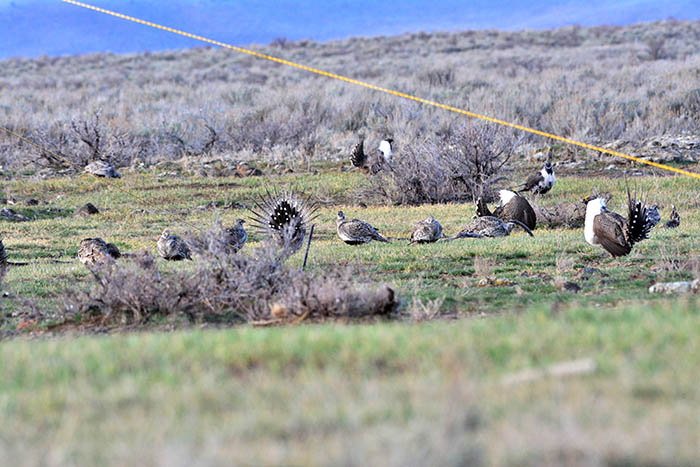Sage grouse study aims to keep bird off endangered species list
Outdoors
0 Updated at 12:35 pm, August 26th, 2015 By: Bill Schiess, EastIdahoNews.com ST. ANTHONY — State and federal researchers have teamed up for a two-year study on the greater sage grouse, which may soon be listed as endangered.
ST. ANTHONY — State and federal researchers have teamed up for a two-year study on the greater sage grouse, which may soon be listed as endangered.The Idaho Fish and Game Department and the Bureau of Land Management’s study is designed to see what habitat is best for nesting and brooding and overall survival of adult birds.
The possibility of the nation’s largest grouse being on the Endangered Species List looms over users of desert areas in 11 states. The bird being listed could close large portions of sage grouse habitat for all human use, including grazing cattle, drilling for oil and gas, recreation, and travel.
Last spring, north of St. Anthony between the Red Road and the Sand Creek Road, researchers had 40 radios ready to place on the hens. They found it difficult to capture the birds as they gathered on their breeding grounds. The hens, leery of any potential danger from overhead, would not move under the drop nets to be captured.

“We have to do something different as they will not walk under the net,” said a frustrated Eric Anderson, regional habitat biologist for the Idaho Fish and Game. “We have these devices that need to be placed on hens to track them for the next two years before the breeding ends.”
Eventually, with the aid of canon nets, 36 hens were captured and fitted with the tracking devices before nesting began last spring.

The study is funded by the BLM from the fuels program as wildfires have destroyed large tracks of sage grouse habitat. Between State Highway 33 and the Egin/Hamer Road, fires have destroyed or forced birds to abandon seven traditional breeding grounds in the last six years.
“Fires have the greatest impact on the sage grouse of anything we see,” Devin Englestead, a wildlife biologist for the BLM and point-man for the study, said. “We have set up 130 habitat monitoring spots to see what they like the best.”

During the summer tracking program, of the 36 hens with tracking units, 30 attempted to nest, 18 had successful nests; but by the time the chicks could fly, only six hens had at least one chick. Two of the hens were killed by predators, seven of the nests were destroyed by predators and four were abandoned by the hens. Two of the tracking devices failed and one fell off the bird.
“The moralities are about normal with most of the other studies that have been done,” Englestead said. “One of the most interesting things we have found so far is the migration of these hens after their attempt to nest.”
Most of the hens migrated north through Targhee National Forest to the Shotgun Valley near Island Park Reservoir where they have spent most of the summer. But one hen broke the pattern and instead of going north moved south and set up home near Juniper Mountain at the edge of the St. Anthony Sand Dunes.

“The ones that traveled north left days apart but used the same migration route, stopping in pockets of sage in the forest,” Englestead said. “They took only one and a half days to get from their nesting area to where they are now. We don’t know if they flew or walked and hopefully we will find that out in the future.”
With the Idaho Fish and Game Commission setting a six-day, one-bird-per-day season this year, there is some concern about the birds with the electronic devices.
“I would not promote hunting in this area,” Englestead said. “I don’t want our birds shot with the radios on them. But if one gets harvested we need the device returned to us.”
The study will be for at least two years with more hens captured and fitted with tracking equipment next spring.
“We have a lot to learn about sage grouse and their habitat in helping them to survive as a species,” Anderson said.


No comments:
Post a Comment